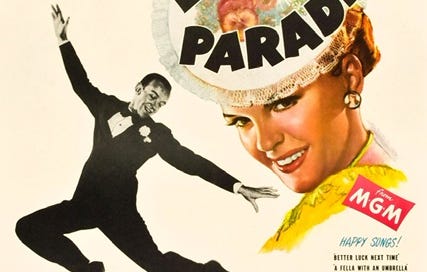Billed as Irving Berlin’s Easter Parade, this 1948 movie pairs Judy Garland with Fred Astaire for the first, last and only time on screen. It’s fabulous in every frame, whether watching on Easter Sunday, springtime or anytime. There’s not a whiff of religion. The plot—thin as ever, as in most Fred Astaire pictures—begins in earnest when Judy Garland’s ingenue character, a chorus girl, auditions for Fred Astaire‘s show-stopping act on Easter Sunday. The joie de vivre of a secular Easter ethos of joy, fertility and springtime comes through. It’s right there in the first line of dialogue. Fred Astaire’s character, Don (originally conceived for Gene Kelly, who injured an ankle during rehearsal), cheerfully walks along an avenue in New York City, greeting a stranger with: “Happy Easter.” Soon, everyone’s exchanging the simple greeting in the city.
Such is the spirit of this delightful movie with wonderful songs and dances. Colorful, extravagant hats and costumes, a silly pantomime describin…
Keep reading with a 7-day free trial
Subscribe to Autonomia to keep reading this post and get 7 days of free access to the full post archives.




